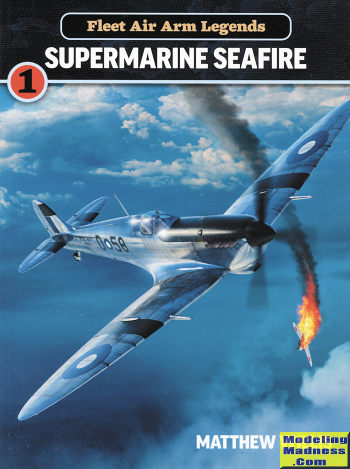 This
book is the first I've seen from this publisher and it is also the first in what
I hope becomes an ongoing series on aircraft of the Fleet Air Arm.
This
book is the first I've seen from this publisher and it is also the first in what
I hope becomes an ongoing series on aircraft of the Fleet Air Arm. Morton Book's Supermarine Seafire
| Author/Artists: | Matthew Willis |
|
Publisher/Distributor |
Morton Books/Casemate |
|
Price |
$19.99 from Casemate |
|
Reviewer: |
|
| Notes: | 114 pages, softbound photos and color profiles. ISBN 978-1-911658290 |
 This
book is the first I've seen from this publisher and it is also the first in what
I hope becomes an ongoing series on aircraft of the Fleet Air Arm.
This
book is the first I've seen from this publisher and it is also the first in what
I hope becomes an ongoing series on aircraft of the Fleet Air Arm.
The FAA's history regarding aircraft was fairly straight-forward prior to WW2. Their carrier mission was to provide support for the fleet. This basically meant reconnaissance at sea, torpedo and bomb attack of ships at sea and fending off other aircraft from other carriers. As a result, the FAA tended towards both multi-purpose aircraft, and those aircraft that could carry more than one crew member. The additional member was often needed to either do gunfire spotting or to operate the HF radio as FAA planes frequently travelled far from the ship and needed the additional radios. For fighters, biplanes were the norm for a long time as these types were fairly easy to land on pitching carriers. When monoplanes came into being, those also had to have good slow speed handling.
It was not expected for these aircraft to operate that much against land or near shore targets. There, these planes might have to combat land based fighters, aircraft that were generally superior in speed and armament to naval fighters defending the ships.
As the war progressed, the need for modern shipboard fighters became acute. Some Grumman Martlet/Wildcats came from the US to meet the need, but the numbers were small as the US also needed them. One short term fix was to use navalized Hurricanes, but by the time those got on ships, they were obsolescent, were frequently modifications of 'extra' planes from the RAF, and did not have folding wings which meant that on most carriers they could not be spotted below the main deck. The option was to develop the Spitfire, specifically the Mk.V, into a navalized Spitfire or Seafire.
This is the story of that aircraft. The Seafire was really not a good match to carriers even when fully navalized with folding wings. The planes crashed frequently due to their fairly weak landing gear and tricky low speed handling. The Seafire III and XV was also considered a marginal aircraft due to some aerodynamic quirks and were it not for the war, would never have been accepted for service. None of the wartime variants had really acceptable endurance as delivered.
The author does a superb job of telling the story of this interesting aircraft. The book is well researched and provides insights into the the development and subsequent issues with each of the variants. As with every military weapons system, there was some political wrangling within the service concerning the usefulness of the aircraft. I got the feeling while reading this that if the US had supplied enough Wildcats, Hellcats and Corsairs, that the Seafire might never have existed as all three types were more well suited to the environment than the Seafire. When one adds in the great pilot stories, excellent choice of period photos and the nicely done full color profiles, you have a book that is a must for the enthusiast and modeler alike.
June 2020
Review book courtesy of Casemate Publishing, You can get yours today at this link.
If you would like your product reviewed fairly and quickly, please contact me or see other details in the Note to Contributors.